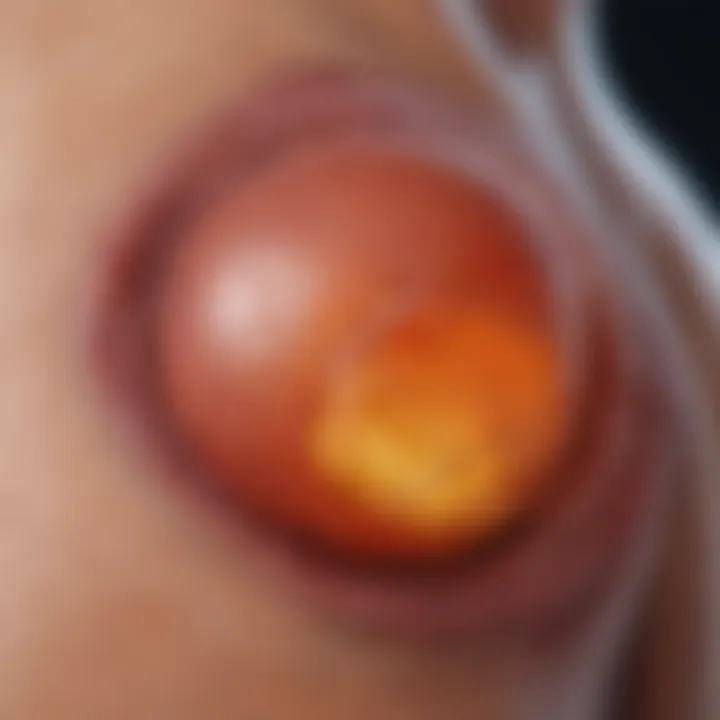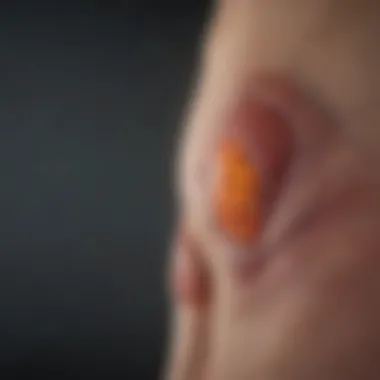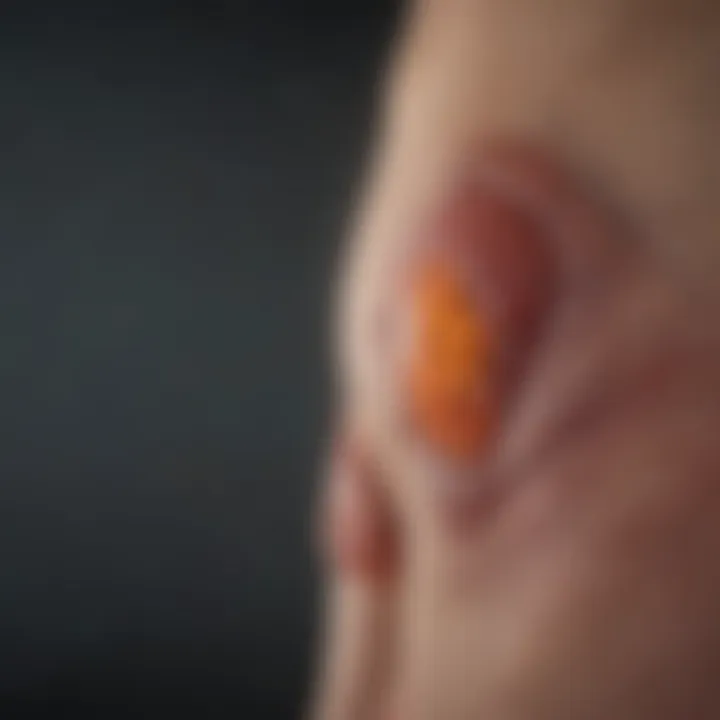Understanding Noninvasive Papillary Urothelial Carcinoma


Intro
Noninvasive papillary urothelial carcinoma (NPUC) represents a significant challenge in the field of bladder cancer research and management. As a frequent variant of bladder malignancy, understanding its characteristics is crucial for improving patient outcomes. This article delves into the intricate details of NPUC, focusing on its epidemiology, pathophysiology, diagnosis, treatment approaches, and future research avenues.
Access to comprehensive information on NPUC is essential for healthcare professionals, researchers, and educators. By synthesizing up-to-date research findings, a better grasp of this condition and its implications can be achieved. This exploration aims not only to illuminate the key aspects of NPUC but also to provide a framework for future investigations, ultimately enhancing clinical practices in the field of oncology.
Research Highlights
Overview of Key Findings
The current literature has shed light on several critical facets of noninvasive papillary urothelial carcinoma:
- Prevalence: NPUC is a common form of bladder cancer, with varying incidence across demographics, particularly affecting older adults and males more frequently.
- Pathophysiological Insights: The molecular characteristics of NPUC reveal a complex interaction of genetic mutations and environmental factors that contribute to tumor development.
- Diagnosis and Staging: Advanced imaging and cystoscopy techniques have enhanced diagnostic accuracy, allowing for earlier detection and better patient stratification.
- Treatment Approaches: Transurethral resection and intravesical therapies are the primary methods employed to manage NPUC, with ongoing studies exploring adjunct therapies.
"Understanding the evolution of treatment methods is critical for improving the management of patients with noninvasive papillary urothelial carcinoma."
Significance of the Research
Research on NPUC is not just an academic exercise; it has real-world implications. By elucidating the characteristics of this type of cancer, healthcare providers can tailor their strategies more effectively. Furthermore, identifying the genetics and molecular pathways involved in NPUC could lead to novel therapeutic targets. Ultimately, this research is vital for the enhancement of patient care and outcomes across oncology.
Original Research Articles
Summary of the Article
Numerous original research articles have contributed to our understanding of NPUC. These studies typically focus on the epidemiological trends, molecular characteristics, and evolving treatment methods. Collectively, they paint a picture of a dynamic field where knowledge is ever-expanding.
Author Contributions
Various researchers and institutions have collaborated on significant findings pertaining to NPUC. Their collective contributions delve into:
- Genetic studies identifying biomarkers associated with NPUC.
- Clinical trials evaluating the efficacy of new treatment modalities.
- Comparative studies documenting patient outcomes based on different management strategies.
This ongoing work reinforces the need for a concerted effort in research to enhance management strategies for NPUC.
Prelims to Noninvasive Papillary Urothelial Carcinoma
Noninvasive papillary urothelial carcinoma (NPUC) is a significant topic in urological oncology, meriting a thorough exploration. Understanding this condition is crucial for healthcare professionals working in the field of cancer treatment. NPUC represents a subtype of bladder cancer, and its unique characteristics require comprehensive examination. The focus of this section is to delve into its definition and classification, followed by a historical context that will enrich the reader's knowledge contextualizing this malignancy.
Definition and Classification
Noninvasive papillary urothelial carcinoma is defined as a malignant neoplasm that arises from the urothelium of the bladder and presents itself in a papillary form. Importantly, the term "noninvasive" indicates that the carcinoma has not penetrated through the bladder's muscular wall, distinguishing it from more aggressive forms of bladder cancer. Classification of NPUC usually involves the examination of histological features and cancer grades, which categorize the tumor based on how it appears under the microscope. The World Health Organization (WHO) classifies NPUC into low-grade and high-grade variants, each with distinct clinical behaviors and prognostic outcomes.
Understanding these classifications aids clinicians in selecting appropriate management strategies and prognosticating patient outcomes.
Historical Context
The recognition of noninvasive papillary urothelial carcinoma has evolved significantly over the past few decades. Early approaches to diagnosing bladder cancer focused primarily on invasive types, leading to a gap in recognition of noninvasive variants. It was not until the late 20th century that NPUC gained more visibility in scholarly journals and clinical practices.
Studies conducted by Turner et al. and later by WHO played pivotal roles in defining the characteristics of NPUC, influencing treatment protocols and disease management. The increasing incidence rates and the understanding of risk factors associated with NPUC, such as smoking, chemical exposure, and genetic predisposition, have motivated further research. As a result, contemporary medical literature now extensively documents this subtype, cementing its importance in oncology discussions.
The evolution of research on NPUC reflects broader advances in cancer diagnostics and treatment, aligning clinical practice with emerging scientific evidence.
In summary, grasping the definition, classification, and historical advancements of noninvasive papillary urothelial carcinoma is paramount for healthcare professionals. This knowledge lays the foundation for subsequent sections of this article that will delve deeper into the epidemiology, pathophysiology, and treatment approaches relevant to NPUC.
Epidemiology
Epidemiology plays a critical role in understanding noninvasive papillary urothelial carcinoma (PUC). This subfield of public health examines the distribution and determinants of disease within populations. By analyzing epidemiological data, researchers and healthcare officials gain insights into patterns of incidence and prevalence, which are vital for developing effective prevention strategies. Furthermore, understanding the risk factors associated with PUC allows for better patient screening and tailored interventions.
Incidence and Prevalence
The incidence of noninvasive papillary urothelial carcinoma is notably higher than many malignancies. In the United States, bladder cancer ranks as the fourth most common cancer among males and the ninth among females. Studies indicate that approximately 80% of bladder cancers are diagnosed at the noninvasive stage, making PUC the predominant histological type. The lifetime risk of developing bladder cancer varies significantly by gender and age, with men being affected four times more than women.
Another vital aspect is the prevalence of noninvasive papillary urothelial carcinoma. It is estimated that around 600,000 individuals are living with a history of bladder cancer in the United States alone. Given the high recurrence rate associated with PUC, this figure underscores the disease's impact on public health.
Risk Factors
The development of noninvasive papillary urothelial carcinoma is influenced by several risk factors. These include:


- Smoking: A significant risk factor, as tobacco use is linked to nearly 50% of bladder cancer cases. The carcinogens present in tobacco can damage the urothelium, increasing susceptibility to malignant transformations.
- Chemical Exposures: Occupational exposure to certain chemicals, like aniline dyes or aromatic amines, is associated with higher incidence rates of bladder cancer. Frequent contact with these substances is common in industries such as dye manufacturing and rubber processing.
- Chronic Inflammation: Conditions such as urinary tract infections and cyclophosphamide treatment can lead to chronic irritation and inflammation of the bladder lining, raising the risk of cellular changes.
- Age and Gender: The risk increases with age, especially in individuals over 55 years. As mentioned earlier, men are more likely to develop PUC than women, which suggests gender-related biological differences in susceptibility.
- Race and Ethnicity: Some studies suggest that Caucasians have a higher incidence of bladder cancer than African Americans and Hispanics, yet the reasons for these disparities remain unclear.
Recognizing these factors allows researchers and clinicians to develop targeted prevention strategies and improve early detection in at-risk populations. Understanding epidemiology's insights into noninvasive papillary urothelial carcinoma can ultimately lead to better patient outcomes.
Pathophysiology
Understanding the pathophysiology of noninvasive papillary urothelial carcinoma is crucial for comprehending the behavior and progression of this type of cancer. This area delves into how the carcinoma develops, its growth patterns, and the molecular factors influencing its characteristics. An in-depth examination of these elements can aid in early detection and improve treatment strategies.
Histological Features
The histological features of noninvasive papillary urothelial carcinoma encapsulate the cellular architecture and morphological changes that distinguish it from other forms of urothelial carcinoma.
When analyzed under a microscope, the tumor typically presents as a finger-like projection, or a papilla, characterized by a central fibrovascular core surrounded by atypical urothelial cells. These cells generally show nuclear atypia, and the presence of increased mitotic activity is often observed, indicating a higher proliferative potential.
Additionally, the absence of invasive characteristics into the underlying tissue layers is a hallmark of noninvasive forms. This trait is significant because it determines the therapeutic approach, as noninvasive tumors generally have a better prognosis than their invasive counterparts.
Histopathological examination is vital for proper diagnosis and grading of carcinoma, thereby directly influencing treatment plans.
Molecular Mechanisms
The molecular mechanisms underpinning noninvasive papillary urothelial carcinoma involve a variety of genetic alterations and signaling pathways that contribute to its pathogenesis. These mechanisms can include the mutation of key genes such as TP53 and FGFR3.
- TP53 is often mutated in many cancer types, leading to disrupted cell cycle regulation, while FGFR3 mutations typically correlate with a less aggressive clinical behavior.
- Additionally, studies suggest aberrations in the PI3K/Akt pathway may play a role in cell survival and proliferation, further complicating the balance between normal and cancerous cells.
Understanding these molecular interactions not only provides insight into the disease's nature but is also crucial for potential targeted therapies. Identifying these pathways can uncover new treatment avenues, which can significantly enhance patient outcomes.
"The integration of histological and molecular perspectives is foundational for advancing the understanding of noninvasive papillary urothelial carcinoma."
In fact, advancements in genetic profiling and molecular diagnostics are pivotal for developing personalized medical strategies that can lead to more effective management of this carcinoma.
Diagnosis
The section on diagnosis is critical in understanding noninvasive papillary urothelial carcinoma. Early detection is paramount, as it significantly influences the management and outcomes of patients. Diagnostic approaches must be methodical, ensuring accuracy in identifying the presence and characteristics of the carcinoma. Through this, healthcare professionals can tailor appropriate treatment plans and provide reliable prognostic information to their patients.
Diagnostic Imaging Techniques
Imaging techniques play a vital role in the diagnosis of noninvasive papillary urothelial carcinoma. Common modalities include ultrasound, computed tomography (CT) scans, and magnetic resonance imaging (MRI). Each of these imaging methods provides essential information about the bladder's morphology and can assist in identifying potential tumors.
- Ultrasound is typically the first line of investigation. It is non-invasive and helps in assessing bladder distension and wall thickness. It can show the overall structure of the bladder without using ionizing radiation.
- CT scans offer detailed images and are particularly useful in revealing the extent of disease, involvement of adjacent structures, and possible metastasis. The contrast-enhanced CT can improve visualization of any irregularities in the bladder wall.
- MRI is increasingly used for patients with concerns about ionizing radiation. It provides excellent contrast resolution between normal and abnormal tissues, aiding in distinguishing between benign and malignant lesions.
In addition to these methods, the integration of advanced technologies like positron emission tomography (PET) scans can significantly enhance diagnostic precision. This multifaceted approach ensures that clinicians have a comprehensive understanding of the patient’s condition, paving the way for effective management.
Cytological Examination
Cytological examination is an indispensable aspect of diagnosing noninvasive papillary urothelial carcinoma. It involves collecting cells shed from the bladder lining, which can then be evaluated under a microscope for cancerous changes. This method offers several advantages:
- Minimally Invasive: The process usually involves a simple urine sample, making it less invasive than other diagnostic methods.
- Cost-Effective: Cytological tests are generally less expensive compared to advanced imaging techniques, thus extending access to more patients.
- Detection of Recurrence: Regular cytological assessments can help in monitoring patients after treatment, contributing to early detection of recurrence.
However, cytology also has its limitations. The accuracy can be affected by inflammation or benign conditions, potentially leading to false negatives. Therefore, cytology is often used in conjunction with imaging studies and other technologically advanced diagnostic tools for a more definitive diagnosis.
In summary, a thorough diagnostic assessment that leverages both imaging techniques and cytological examination is crucial in managing noninvasive papillary urothelial carcinoma effectively. Early and accurate diagnosis not only impacts treatment choices but also influences patient survival rates.
Staging and Grading
Staging and grading are critical elements in the diagnosis and management of noninvasive papillary urothelial carcinoma. These processes provide a systematic framework to assess the extent of disease and its biological behavior. A clearer understanding of staging and grading aids healthcare professionals in treatment planning and predicting patient outcomes. Furthermore, these assessments allow for the stratification of patients based on the risk of recurrence or progression, which is paramount in the personalized management of bladder cancer.
TNM Staging System
The TNM staging system is an internationally recognized method for classifying cancer based on three key components: Tumor size (T), Node involvement (N), and Metastasis (M). In the context of noninvasive papillary urothelial carcinoma, the significance of this system cannot be overstated. This classification helps in making informed decisions about treatment strategies and provides a language for oncologists to communicate effectively about patients’ conditions.
- Tumor Size (T): Noninvasive cases are primarily classified as T1 when there is evidence of tumor presence within the innermost layer of the bladder wall but without invasion of deeper tissue. Understanding the size and extent of the tumor helps in deciding the urgency of treatment plans.
- Node Involvement (N): For most noninvasive forms, lymph node involvement is rare, but it's crucial to rule it out as part of comprehensive staging. The absence of node involvement suggests a better prognosis.
- Metastasis (M): Metastasis denotes the presence of cancer spread beyond the bladder. Noninvasive papillary urothelial carcinoma typically does not present with distant metastasis at diagnosis, making early intervention more promising.
The accurate application of the TNM system informs clinical decisions, facilitates research comparisons, and utilizes standardized protocols for the management of patients. It ultimately helps to clarify prognosis and tailor approaches to therapy.
Histologic Grading
Histologic grading of noninvasive papillary urothelial carcinoma offers insight into the tumor's appearance under the microscope, reflecting its potential for aggressive behavior. Pathologists typically use a three-tiered grading system: low-grade, high-grade, and variants. Understanding the grade helps in predicting the risk of recurrence.


- Low-grade: These tumors exhibit well-differentiated features and show a low likelihood of progression or invasion.
- High-grade: In contrast, high-grade tumors are more atypical and associated with a higher risk for invasiveness and recurrence, making timely and aggressive treatment imperative.
- Variants: Various histological variants may display unique characteristics, which can influence prognosis and treatment choices.
Correct grading is essential for determining the appropriate clinical approach and monitoring strategies. It informs the medical team about the potential aggressiveness and treatment outcomes, creating a basis for patient-centered care.
Understanding both staging and grading is vital to tailoring treatment strategies and predicting patient outcomes effectively.
By unpacking these elements, healthcare professionals gain a deeper comprehension of the disease's complexity, ultimately leading to better patient care.
Treatment Approaches
In the management of noninvasive papillary urothelial carcinoma, treatment approaches are critical for patient outcomes. The chosen methods significantly affect the control of the disease and the quality of life for patients. It's essential to consider factors such as tumor stage, patient health, and individual preferences when determining the optimal strategy. The two primary treatments discussed here are Transurethral Resection and Intravesical Therapy.
Transurethral Resection
Transurethral resection (TUR) is one of the cornerstone treatments for noninvasive papillary urothelial carcinoma. This procedure involves the removal of tumors through the urethra, which avoids the need for an external incision. TUR is favored for its minimally invasive nature, which leads to quicker recovery times and less postoperative pain compared to open surgical methods.
The effectiveness of TUR is underscored by its ability to provide both therapeutic and diagnostic benefits. During the procedure, oncologists can obtain histological samples for accurate staging and grading. This is important since the understanding of tumor characteristics can facilitate tailored treatment for each patient.
However, TUR is not without considerations. There is a risk of complications such as bleeding and infection. Furthermore, complete resection may not be possible for larger tumors, which can lead to a risk of recurrence. Careful patient selection and follow-up are crucial for managing these risks effectively.
Intravesical Therapy
Intravesical therapy is another significant component in the treatment of noninvasive papillary urothelial carcinoma. This approach involves delivering chemotherapeutic agents directly into the bladder. The most commonly used agents include Bacillus Calmette-Guérin (BCG) and mitomycin C.
The primary advantage of intravesical therapy is its localized effect, which minimizes systemic toxicity often associated with chemotherapy. Localized treatment can reduce the recurrence rates of tumors and can improve overall survival.
BCG, in particular, has shown substantial efficacy in preventing recurrence after TUR, making it a preferred option. However, some patients may experience side effects such as bladder irritation or flu-like symptoms. Close monitoring during treatment plays a critical role in managing these adverse effects and ensuring therapy effectiveness.
Effective management of noninvasive papillary urothelial carcinoma requires a nuanced approach that balances treatment efficacy with patient safety.
In sum, the choice between Transurethral Resection and Intravesical Therapy involves careful consideration of individual circumstances, tumor characteristics, and patient preferences. Understanding these treatment options is vital for healthcare professionals as they strive to optimize outcomes for patients with noninvasive papillary urothelial carcinoma.
Patient Outcomes
Understanding patient outcomes in noninvasive papillary urothelial carcinoma is crucial for both clinicians and patients. This section delves into survival rates and recurrence rates, which provide a comprehensive view of what patients can expect following diagnosis and treatment. Clinicians rely on this data to tailor treatment approaches, while patients can make informed decisions about their health. Evaluating patient outcomes also sheds light on the effectiveness of various therapies and the overall prognosis associated with this carcinom.
Survival Rates
Survival rates are strictly linked to the stage and grade of noninvasive papillary urothelial carcinoma at diagnosis. Generally, the prognosis is favorable compared to more invasive forms of bladder cancer. One of the most significant factors influencing survival is the early detection of the carcinoma. Studies show that patients diagnosed at an earlier stage tend to have significantly higher survival rates, often above 90% at 5 years.
Factors impacting survival rates include:
- Histologic features: Noninvasive papillary urothelial carcinoma that exhibits low-grade characteristics often has a better prognosis than high-grade lesions.
- Patient age and overall health: Younger patients and those with fewer comorbidities tend to have better survival outcomes.
- Treatment effectiveness: The use of therapies such as transurethral resection and intravesical immunotherapy contributes positively to improving survival rates.
"Data from various cancer registries suggest that the overall 5-year survival rate for patients with noninvasive papillary urothelial carcinoma often exceeds 80% to 90%."
Recurrence Rates
Recurrence rates represent a significant challenge in the management of noninvasive papillary urothelial carcinoma. Despite high initial survival rates, the risk of recurrence can be quite substantial. Estimates suggest that recurrence occurs in approximately 50% to 70% of patients within the first five years after initial treatment.
Key considerations regarding recurrence rates include:
- Monitoring protocol: Regular follow-ups using imaging and cystoscopy are vital for early detection of recurrent tumors, which can help improve outcomes.
- Histologic grade: The likelihood of recurrence often correlates with the initial tumor grade. Higher-grade tumors are more likely to recur and may require more aggressive monitoring.
- Treatment variables: The choice of treatment can also influence recurrence. For instance, patients receiving intravesical therapy may experience different recurrence rates compared to those who undergo only surgical intervention.
Impact of Genetics
Genetics plays an essential role in understanding noninvasive papillary urothelial carcinoma. The genetic landscape of this type of bladder cancer can significantly influence patient outcomes and treatment strategies. By exploring the genetic alterations present in tumors, healthcare professionals can better predict the behavior of the cancer and tailor therapies accordingly.
Moreover, comprehending genetic factors helps in identifying at-risk populations. Those with certain heritable mutations or family histories may require more rigorous monitoring. This knowledge can drive preventive measures and early interventions, which are critical in managing this disease effectively.
Genetic Alterations
Genetic alterations, such as mutations in specific genes, are pivotal in the development and progression of noninvasive papillary urothelial carcinoma. The most notable genes involved include FGFR3, TP53, and HRAS.
- FGFR3 mutations are commonly associated with low-grade tumors and often indicate a more favorable prognosis.
- On the other hand, alterations in TP53 are typically linked with higher-grade tumors and a poorer outcome.
- HRAS mutations, while less frequent, can also contribute to the aggressiveness of the disease.
These genetic modifications can lead to changes in cellular pathways that control growth and division, ultimately resulting in carcinogenesis. The detection of these alterations can be facilitated through advanced techniques such as next-generation sequencing, which allows for a more nuanced understanding of an individual’s tumor profile.


Understanding these genetic aspects can help researchers formulate targeted therapies that might improve treatment effectiveness, potentially moving towards a precision medicine approach.
Familial Risk Factors
Familial risk factors denote the genetic predisposition to develop noninvasive papillary urothelial carcinoma based on family history. Research indicates that individuals with first-degree relatives who have had bladder cancer may present a significantly elevated risk themselves. This familial linkage raises several critical considerations:
- Genetic Counseling: Families with a history of bladder cancer could benefit from genetic counseling, allowing for risk assessment and informed decisions regarding screenings.
- Preventive Screenings: Enhanced surveillance for at-risk individuals can facilitate earlier detection. Low-grade tumors diagnosed at early stages often have better outcomes.
- Research Directions: Understanding familial links can aid scientific inquiries into shared environmental or lifestyle factors, as well as inherited genetic mutations that may be contributing to the disease.
Ultimately, recognizing the role of genetics in noninvasive papillary urothelial carcinoma enables a more strategic approach to both diagnosis and treatment, fostering the potential for personalized care.
Innovations in Research
Research innovations are crucial in advancing the understanding and treatment of noninvasive papillary urothelial carcinoma. This section highlights key developments, focusing on emerging biomarkers and therapeutic advancements. A solid grasp of these innovations can lead to better diagnostic methods, targeted therapies, and improved patient outcomes. In an era where precision medicine is becoming increasingly significant, the integration of novel research findings into clinical practice remains essential.
Emerging Biomarkers
Emerging biomarkers offer substantial promise in improving the diagnosis and treatment of noninvasive papillary urothelial carcinoma. These biomarkers, which are specific indicators of the disease’s presence or progression, can enhance the accuracy of clinical assessments.
- Uroplakin and NMP22: These biomarkers have been investigated for their roles in early detection. Studies suggest that they may correlate with tumor stage and the risk of recurrence, providing valuable prognostic information.
- FGFR3 Mutations: Alterations in the FGFR3 gene have been linked to noninvasive papillary urothelial carcinoma. Identifying these mutations can help in stratifying patients and determining their risk profiles.
- Urinary Biomarkers: Recent studies examine various urinary biomarkers, such as UroVysion and UroMark, which offer a non-invasive approach to monitoring disease status.
These biomarkers could lead to more personalized treatment strategies. As research continues, their role in clinical settings may expand significantly.
Therapeutic Advancements
Therapeutic advancements in the management of noninvasive papillary urothelial carcinoma reflect a shift towards more effective and tailored treatment options.
- Immunotherapy: Recent trials explore the application of checkpoint inhibitors for patients with noninvasive bladder cancer. These treatments harness the body's immune system to target tumor cells, presenting an innovative avenue for therapy.
- Intravesical Therapy Improvements: Innovations in drug delivery systems for intravesical therapy are notable. For instance, enhancing the efficacy and retention time of Bacillus Calmette–Guérin (BCG) therapy is currently a focus in research, as BCG remains a standard treatment for superficial bladder cancer.
- Targeted Therapies: Targeted therapies, such as those directed at specific molecular pathways involved in tumor growth and progression, show promise. Drugs that inhibit pathways influenced by alterations in FGFR3 or other genes are being tested in clinical trials.
Advancements in therapeutic options, emphasizing personalized medicine, may lead to improved outcomes and decreased recurrence rates.
Key Insight: Incorporating findings from biomarker research into therapeutic strategies can refine treatment approaches for noninvasive papillary urothelial carcinoma, potentially changing patient prognosis and experiences.
Future Directions
The field of noninvasive papillary urothelial carcinoma is at a critical juncture, requiring focused attention on future directions to improve outcomes for patients. Understanding the nuances of this condition will benefit greatly from ongoing research and innovation. Identifying specific areas for exploration and developing patient-centered care models are key considerations.
Potential Research Areas
Research in noninvasive papillary urothelial carcinoma should emphasize several critical areas:
- Biomarker Development: Exploring novel biomarkers could enhance diagnosis and allow for better stratification of patients based on risk.
- Genetic Profiling: Further investigation into genetic alterations may yield insights into tumor behavior and potential therapeutic targets.
- Pathway Analysis: Understanding molecular pathways involved in tumor growth will be essential in identifying new treatment options.
- Treatment Resistance: Studying reasons for treatment resistance and recurrence can lead to more effective management strategies.
- Quality of Life Research: Exploring how treatments impact patients' quality of life will ensure that care is comprehensive and addresses the holistic needs of individuals.
Future research initiatives could be influenced by advances in technology and increased funding for clinical studies, leading to a deeper comprehension of the disease.
Patient-Centered Care
Transitioning towards a patient-centered approach is fundamental in the management of noninvasive papillary urothelial carcinoma. This model emphasizes the significance of involving patients in their care plans. Effective communication between patients and healthcare providers is vital. By educating patients about their condition, treatment options, and potential outcomes, healthcare providers can foster a collaborative relationship.
To achieve patient-centered care, the following aspects should be considered:
- Tailored Treatment Plans: Individualized treatment plans should be developed based on patient preferences and unique clinical profiles.
- Support Services: Offering psychological support and resources for coping can greatly improve patient experiences during their treatment journey.
- Active Patient Participation: Encouraging patients to participate in clinical trials or research activities can allow them to contribute to advancements in the field.
In summary, emphasizing future research areas and prioritizing patient-centered care will be essential to advance the field of noninvasive papillary urothelial carcinoma. Through these efforts, we can hope for improved diagnostic accuracy, treatment efficacy, and overall patient outcomes.
Closure
The conclusion of this article plays a critical role in summarizing the extensive insights gained about noninvasive papillary urothelial carcinoma. It encapsulates the essential findings across various sections, detailing the cancer's epidemiology, pathophysiology, diagnostic methods, and treatments. This synthesis not only reinforces the importance of a multifaceted understanding of this condition but also emphasizes the ongoing need for research and advancements in patient care.
By highlighting the complexity of noninvasive papillary urothelial carcinoma, the conclusion serves as a reminder of the cancer's impact on patients’ lives. It underlines the relevance of precise diagnostic techniques, effective treatment strategies, and the integration of genetic insights into patient management. The summary encourages all stakeholders in the healthcare system to recognize the significance of their roles in addressing this prevalent form of bladder cancer.
In particular, it is crucial that healthcare professionals remain updated on the latest research and emerging therapies. This ensures the best possible outcomes for patients and contributes to the wider field of oncology. Furthermore, as the understanding of noninvasive papillary urothelial carcinoma evolves, continuous education and adaptation in clinical practices will become essential.
"A comprehensive view is essential for effective treatment and patient care in oncology."
Summary of Key Points
In this article, several key points regarding noninvasive papillary urothelial carcinoma have been thoroughly discussed:
- Definition and Classification: Understanding the types and stages of the carcinoma aids in precise diagnosis and treatment.
- Epidemiology: Incidence and prevalence statistics highlight the significance of awareness and screening.
- Pathophysiology: Knowing the molecular changes involved helps in developing targeted therapies.
- Diagnostic Methods: Various advanced imaging and cytological techniques allow for early detection.
- Treatment Options: Evaluating current approaches provides insights to improve patient outcomes.
- Genetic Factors: Genetic alterations can lead to improved risk assessment and personalized treatment strategies.
- Future Research: Exploring innovative biomarkers and new therapeutic advancements could significantly change management approaches.
Final Thoughts
The ongoing efforts in understanding the genetics and molecular mechanisms underlying this condition will play a pivotal role in shaping future therapeutic strategies. It is essential for researchers, clinicians, and educators to remain engaged with the latest discoveries and trends. The goal remains clear: to ultimately improve survival rates and quality of life for those affected by noninvasive papillary urothelial carcinoma.







